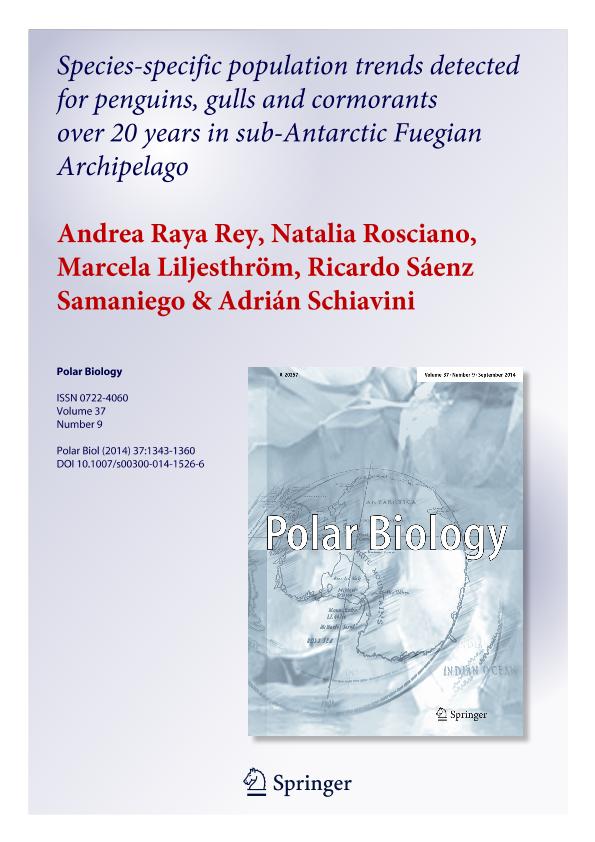Artículo
Species-specific population trends detected for penguins, gulls and cormorants over 20 years in sub-Antarctic Fuegian Archipelago
Raya Rey, Andrea Nélida ; Rosciano, Natalia Gimena
; Rosciano, Natalia Gimena ; Liljesthrom, Marcela
; Liljesthrom, Marcela ; Saenz Samaniego, Ricardo Andres
; Saenz Samaniego, Ricardo Andres ; Schiavini, Adrian Carlos Miguel
; Schiavini, Adrian Carlos Miguel
 ; Rosciano, Natalia Gimena
; Rosciano, Natalia Gimena ; Liljesthrom, Marcela
; Liljesthrom, Marcela ; Saenz Samaniego, Ricardo Andres
; Saenz Samaniego, Ricardo Andres ; Schiavini, Adrian Carlos Miguel
; Schiavini, Adrian Carlos Miguel
Fecha de publicación:
08/2014
Editorial:
Springer
Revista:
Polar Biology
ISSN:
0722-4060
Idioma:
Inglés
Tipo de recurso:
Artículo publicado
Clasificación temática:
Resumen
Understanding the dynamics and causes of population trends are essential for seabird conservation. Long-term studies of seabirds at high-latitude (Antarctic, sub-Antarctic and Arctic) regions have shown contrasting species-specific trends in population size in response to climate change and anthropogenic pressures. We have studied for the last 20 years (1992?2012) the population trends of seven seabird species that breed in the Beagle Channel, south-eastern Tierra del Fuego and at Staten Island, a sub-Antarctic region in southern Argentina. The numbers of Magellanic and Gentoo Penguins increased significantly since 1992 (by[15 % year-1). In comparison, the populations of Imperial Cormorants, Dolphin Gulls and Kelp Gulls increased at slower rates ( % year-1), while the Rock Cormorant population even decreased by 1.3 % year-1. At Staten Island, the numbers of Rockhopper Penguins decreased by 24 % between the censuses of 1998 and 2010, whereas the population of Magellanic Penguins increased by 227 % during the same period. Over the study period, air and sea-surface temperatures remained stable in our study area, suggesting that the detected population changes are not driven by the climate. This finding contrasts with the detected links between increasing temperature trends and seabird population changes reported from Antarctic and Arctic regions. The level of tourism and size of the permanent human population has increased in the Beagle Channel area during the last 20 years and could be responsible for the increase of gull populations. The seabird species that received the highest number of visitors (Imperial Cormorants and penguin species) seem to be adapted or at least indifferent to pressures exerted by tourism, as their populations increased during the study period. In addition, increasing numbers of seabirds in the area may generally be leading to higher abundances of scavenging species (e.g. gulls).
Archivos asociados
Licencia
Identificadores
Colecciones
Articulos(CADIC)
Articulos de CENTRO AUSTRAL DE INVESTIGACIONES CIENTIFICAS
Articulos de CENTRO AUSTRAL DE INVESTIGACIONES CIENTIFICAS
Articulos(SEDE CENTRAL)
Articulos de SEDE CENTRAL
Articulos de SEDE CENTRAL
Citación
Raya Rey, Andrea Nélida; Rosciano, Natalia Gimena; Liljesthrom, Marcela; Saenz Samaniego, Ricardo Andres; Schiavini, Adrian Carlos Miguel; Species-specific population trends detected for penguins, gulls and cormorants over 20 years in sub-Antarctic Fuegian Archipelago; Springer; Polar Biology; 37; 9; 8-2014; 1343-1360
Compartir
Altmétricas



